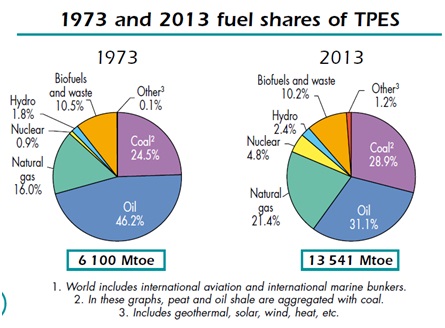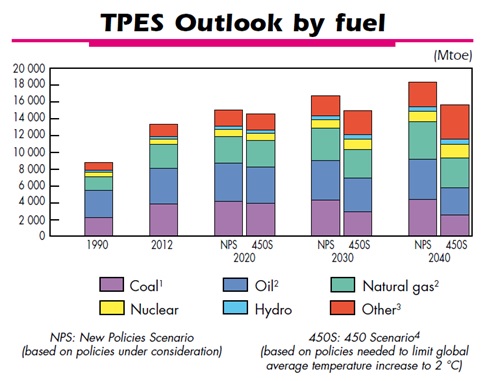The Energy Mix: Where are we heading?
As it stands, the latest report from the International Energy Agency (IEA) indicates that the world’s Total Primary Energy Supply (TPES) was 81% dominated by fossil fuels in 2013 which includes oil (31%), coal (29%) and natural gas (21%). The remaining 19% were broken down as follows: Bio-fuels and waste (10%), Nuclear (5%), Hydro (2.4%) and other - geothermal, solar, wind & heat (1.2%). The trend is slowly moving away from fossil fuels as these represented 87% of TPES in 1973. TPES is the raw energy which ends up in power plants, factories, transportion or even lost. It is measured in million tonne of oil equivalent (Mtoe) which is defined as the amount of energy released by burning one million tonnes of crude oil.

So how are these fuel sources evolving?
Although we have seen countries like Japan, Germany and China adding coal plants these last couple of years, it is simply the dirtiest of all fossil fuels. When we see the smog in Chinese cities, we realize the serious health and safety challenges that the Chinese are facing, which will not be solved by installing more coal plants. It is none the less a cheap and effective short term solution to meet current demand while heavier investments are made in sustainable infrastructure. As for Japan and Germany, coal is used as an intermittent solution while the countries decommission their nuclear facilities.
Nuclear is considered an effective solution by many politicians to meet future energy needs since it provides cheap and low carbon electricity. However, the radioactive waste must be disposed of and there is always that minor possibility of a nuclear disaster. Since Fukushima, countries like Japan, Germany and Taiwan have been in the process of decommissioning their entire nuclear park while countries like the US and France have agreed to reduce their share of nuclear.
Natural gas has been a big gainer this past decade with the fracking revolution. In the US its output has grown +45% since 2005 and has overtaken coal. Although cost effective, debate still rages on its potentially nocive effects on aquifers and groundwater.
With regards to green energy; technological enhancements, economies of scale and government incentives are pushing prices down and demand up. Wind power is proving to be as cheap as coal in some parts of the world while solar panels have seen a significant drop in price since 2008. The development of smart grid and battery storage technologies will be key factors for the development of these energy sources as their inputs are not always puffing or shining. Hydro, on the other hand, can provide a constant stream of electricity available on demand. Nevertheless, dams are limited to only certain locations. As for biofuels and waste, these include wood, crops, ethanol, municipal waste and other organic matter. Since 1973, it has maintained a stable share of the world’s energy supplied. With urbanization on the rise, municipal waste should increase, while new technologies will also play an important role in the development of this fuel type as the inputs are numerous.
If we take a big step back about 3 centuries, we realize that the energy mix is becoming more diversified as technologies evolve and as we are better able to make use of our surrounding environment. In the 19th century, coal replaced wood as the primary source of energy, which was then replaced by oil in the 20th. Although still dominated by oil and other fossil fuels, the beginning of the 21st century seems to be moving away from these towards a more sustainable and diversified energy mix. For one there is a general consensus (or at least awareness) to move away from fossil fuels and there is also rapid technological development in the fields of electric vehicle mobility, battery storage, chemistry, telecommunications, smart grids, etc … which makes us less reliant on fossil fuels as a reliable source of electricity and better able to manage intermittency. The graph below is the IEA’s anticipated energy mix structures from here to 2040 under two scenarios. As we can see, government policies will have an impact on the future of the mix.

